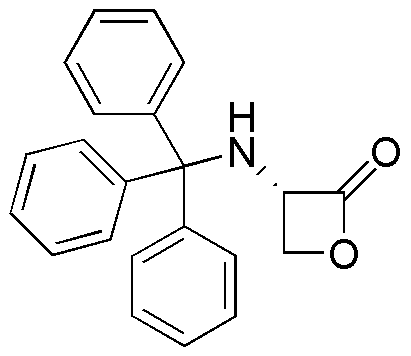Trityl-L-serine lactone is widely utilized in research focused on:
- Peptide Synthesis: This compound serves as a protecting group for amino acids during peptide synthesis, allowing for the selective modification of specific functional groups without interfering with others.
- Drug Development: It plays a crucial role in the development of pharmaceuticals, particularly in creating compounds that require specific stereochemistry for optimal biological activity.
- Bioconjugation: Trityl-L-serine lactone is used in bioconjugation processes, where it helps attach biomolecules to surfaces or other molecules, enhancing the efficacy of drugs and diagnostics.
- Research in Neuroscience: The compound is valuable in studying neurotransmitter systems due to its ability to modify serine residues in proteins, which can influence receptor activity and signaling pathways.
- Material Science: It is also explored in the development of novel materials, particularly in creating polymers with specific functionalities that can be tailored for various applications.
General Information
Properties
Safety and Regulations
Applications
Trityl-L-serine lactone is widely utilized in research focused on:
- Peptide Synthesis: This compound serves as a protecting group for amino acids during peptide synthesis, allowing for the selective modification of specific functional groups without interfering with others.
- Drug Development: It plays a crucial role in the development of pharmaceuticals, particularly in creating compounds that require specific stereochemistry for optimal biological activity.
- Bioconjugation: Trityl-L-serine lactone is used in bioconjugation processes, where it helps attach biomolecules to surfaces or other molecules, enhancing the efficacy of drugs and diagnostics.
- Research in Neuroscience: The compound is valuable in studying neurotransmitter systems due to its ability to modify serine residues in proteins, which can influence receptor activity and signaling pathways.
- Material Science: It is also explored in the development of novel materials, particularly in creating polymers with specific functionalities that can be tailored for various applications.
Documents
Safety Data Sheets (SDS)
The SDS provides comprehensive safety information on handling, storage, and disposal of the product.
Product Specification (PS)
The PS provides a comprehensive breakdown of the product’s properties, including chemical composition, physical state, purity, and storage requirements. It also details acceptable quality ranges and the product's intended applications.
Certificates of Analysis (COA)
Search for Certificates of Analysis (COA) by entering the products Lot Number. Lot and Batch Numbers can be found on a product’s label following the words ‘Lot’ or ‘Batch’.
Numéro de catalogue
Numéro de lot/série
Certificates Of Origin (COO)
This COO confirms the country where the product was manufactured, and also details the materials and components used in it and whether it is derived from natural, synthetic, or other specific sources. This certificate may be required for customs, trade, and regulatory compliance.
Numéro de catalogue
Numéro de lot/série
Safety Data Sheets (SDS)
The SDS provides comprehensive safety information on handling, storage, and disposal of the product.
DownloadProduct Specification (PS)
The PS provides a comprehensive breakdown of the product’s properties, including chemical composition, physical state, purity, and storage requirements. It also details acceptable quality ranges and the product's intended applications.
DownloadCertificates of Analysis (COA)
Search for Certificates of Analysis (COA) by entering the products Lot Number. Lot and Batch Numbers can be found on a product’s label following the words ‘Lot’ or ‘Batch’.
Numéro de catalogue
Numéro de lot/série
Certificates Of Origin (COO)
This COO confirms the country where the product was manufactured, and also details the materials and components used in it and whether it is derived from natural, synthetic, or other specific sources. This certificate may be required for customs, trade, and regulatory compliance.


